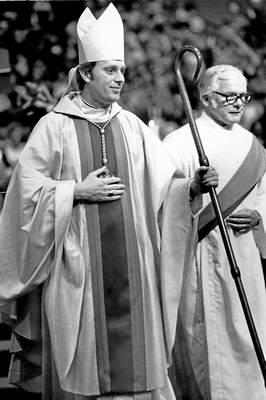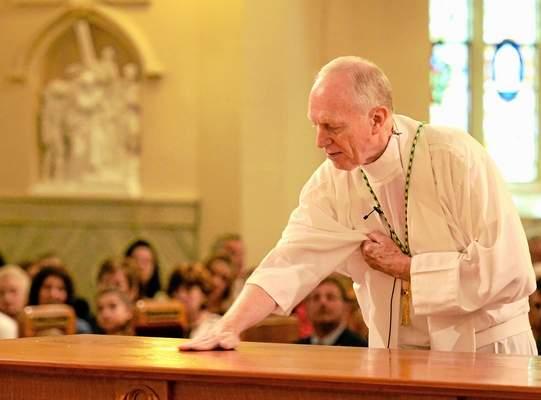Albany Diocese Bishop Hubbard Reflects on His Long Tenure
By Ian Benjamin
ALBANY >> “I’ve come a long way for a boy from the ’Burgh,” said Bishop Howard Hubbard, his voice reverberating within the vaulted arches of the Cathedral of the Immaculate Conception in Albany. For those who know him, that was not a pretentious statement, but rather one reflecting his amazement at being the spiritual leader for nearly 400,000 Catholics for more than three decades. When Howard James Hubbard, then a 38-year-old priest from the Lansingburgh section of Troy, was ordained Bishop of the Roman Catholic Diocese of Albany on March 27, 1977, he was the youngest bishop in the nation. He was dubbed the “boy bishop.” The sobriquet has long since faded, and having served as bishop for more than 36 years, Hubbard is now the longest tenured bishop in the country. When the bishop celebrates his 75th birthday on Oct. 31, his career will begin to conclude. By Papal law, that is the date by which Hubbard must submit his letter of resignation through official channels to the Vatican. It is only once Pope Francis names a successor, however, that he will actually step into retirement. He has led the diocese as shifting demographics have permanently closed the doors of many urban parishes, as fewer Catholics have chosen to take a path to the priesthood, and as victim after victim has come forth with allegations of sexual misconduct against priests. Hubbard knew he would face these issues as a priest, but he never considered that he might face those issues as a bishop, and so it was with surprise that he received a letter from Pope Paul VI in 1977. Hubbard became bishop of the diocese in the midst of the burgeoning HIV/AIDS epidemic, during a time when there was little knowledge of the disease or understanding of its causes. At the time, he was director of pastoral planning as well as a priest at Hope House, a drug rehabilitation and recovery center he had founded in Albany’s South End several years before. After attending a meeting with the council of a small Polish parish in Washington County, Hubbard returned to his room around midnight and found a telegram waiting for him. It said, quite simply, that: “The Holy Father has in mind for you to become the Bishop of Albany.” He had 24 hours to consider the request, and could only speak about the matter with his spiritual director “I just stared at the ceiling all night long, I didn’t get any sleep,” said the bishop during an interview last week. While he had not considered himself a candidate for the position, especially given his young age, Hubbard felt that he had no good reason to refuse. A day later, he sent a telegram to the apostolic nuncio in Washington, the representative of Pope Paul VI to the United States, stating his acceptance. The coded telegram read: “The New York State Conference will address the matter.” During a grand ceremony in the gymnasium of Siena College more than two months later, Hubbard was consecrated the ninth Bishop of the Roman Catholic Diocese of Albany. In contrast to the ornate ceremonial garb he wore during the ceremony, Hubbard has led a life marked by a lack of embellishment. Upon taking office, he had the opportunity to move into one of the palatial homes set aside for the bishop, but instead chose to reside in a nondescript, red brick building across from the cathedral. Hubbard’s years as a priest and his tenure as bishop have been, in large part, defined by the changes that swept the church following the Second Vatican Council. Pope John XXIII opened the ground-breaking council on Oct. 11, 1962, when Hubbard was attending seminary in Rome. It would continue for two years as cardinals, and bishops from across the globe formulated changes to accommodate the church to the changes brought by the modern era. Notably for the Albany Diocese, the council empowered the lay people to take greater responsibility for life in their own parish, and opened the gates for a more collegial relationship between the ordained members and the bishop. Upon taking office, the effect of the latter change pleasantly surprised the bishop. “They were not at all reluctant to let you know what their thoughts and feelings were about matters,” said Hubbard. “It was good that they felt free to communicate, but you didn’t have the level of deference that you might have anticipated went with the episcopal office. And that was a good thing, to have the bishop being taken down from a pedestal, and hopefully better able to relate on a one-to-one basis.” Over the years the bishophas lent his ear to the many concerns of the diocese. During the Second Vatican Council, there were approximately 400 priests throughout the Albany Diocese. Over the decades, that number has slowly dwindled to less than 150, and could drop below 100 in coming years. With 132 parishes in the diocese, and more than one worship site in many of those, the diocese is looking at a future of fewer parish priests than parishes. With 10 present candidates for the priesthood and three prospective candidates to be interviewed over the coming months, the diocese is experiencing a slight uptick in numbers, but not enough to stem the slow decline. In an effort to cover many of the responsibilities taken on by a decreasing number of priests, the diocesan administration has sought to place greater responsibility for the church’s mission with lay persons. Although the sacraments can only be conferred by an ordained member of the church, lay people can now participate in liturgical roles at Mass and other sacraments, preparing couples for marriage, and grievance work. Because of this, the numbers of those doing the church’s ministry are much higher than they were in the 1960s, despite a decrease in ordained members. Meanwhile, populations throughout the 14-county diocese have shifted drastically. By the middle of the first decade of the 21st century, most cities in the diocese — with the notable exception of Saratoga Springs — had lost between 25 and 39 percent of their populations. Those shifts meant that a single parish in Glenville had the same number of attendees at weekend mass — 1,300 — as across six urban churches in Troy. In an ambitious plan to realign diocese resources with the population, Hubbard began an initiative to close churches and consolidate parishes. It was with a heavy heart that Hubbard would shutter 33 churches across the diocese, including his own home parish of St. Patrick’s in Troy, where the bishop received his first communion, was confirmed, and said his first Mass after coming back to the United States from Rome. “It is very heartbreaking,” said Hubbard. “No matter how small a community may be, no matter how much attrition has taken place over the course of time, it is a person’s spiritual home.” As bishop, his priority was to make sure that Mass and the sacraments were available to as many Catholics as possible, and given the decline of those entering religious life, as well as shifting demographics, the diocese “just couldn’t continue as we had been,” said Hubbard. As the bishop has weathered the closure of parishes, he also led the diocese when cases of sexual abuse at the hands of priests have come to light. After the prosecution of five priests in the archdiocese of Boston received national attention in 2002, victims of pedophile priests began to come forward across the nation, creating a crisis for the church in America, and years of trouble for Hubbard. A number of victims have since come forward in the Albany Diocese. In 2004, two men brought allegations of sexual misconduct against Hubbard, but after an exhaustive $2 million investigation led by former prosecutor Mary Jo White, those accusations were found to be baseless. While most of the cases of sexual abuse in the church occurred roughly between 1965 and 1985, the vast majority of the reports on those cases only began gaining national attention following the Boston scandal. The same year the scandal erupted, the church instituted a number of safeguards to prevent the sexual abuse of minors by priests. Those seeking to enter the priesthood are now required to undergo extensive background checks and a long interview process that can last up to a year. Through his many trials, the bishop had taken heart and found fulfillment in his efforts to renew Catholics’ faith. Early in his career, the bishop led a primetime television retreat. Broadcast from the WTEN News Channel 10 studios, the retreat was intended to bring wayward Catholics back to the fold, and reinvigorate the faithful. That effort was followed, years later, with “Renew,” a series of programs aimed at reaching out to the Catholics who had stopped practicing the faith. More recently, the diocese completed “Our Amazing God,” an evangelization effort that aimed to teach faithful Catholics how to respectfully encourage their family, friends, and co-workers to join the faith. “I’ve taken great satisfaction that we’ve made substantial progress in having ownership for the life of the parish, and not just attending Mass and putting money in the collection basket,” Hubbard said. With the bishop’s retirement nearly upon him, Hubbard is planning to stay in the area, although he may move from his current residence across from the cathedral to give the new bishop some room to grow. In the meantime, he has put out a simple request. While the diocese has conducted an extensive $20 million renovation of the Cathedral of the Immaculate Conception, they were not able to implement the master plan, which called for the renovation of the crypt beneath the sanctuary floor. Speaking before those gathered in the cathedral on a recent Sunday, the bishop said he has yet to visit the crypt, but that he knows two facts about it. First, that there is only one niche left, and unless his successor dies before him, it will be his own. And second, that the crypt is in deplorable condition. “If someone could remove the rubble, restore the masonry, and do a thorough cleaning before my demise, I will be very, very grateful,” said the bishop, as the cathedral erupted in laughter. Contact: ibenjamin@troyrecord.com
|
.
Any original material on these pages is copyright © BishopAccountability.org 2004. Reproduce freely with attribution.

